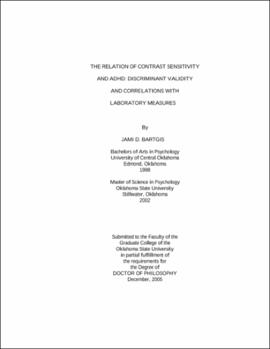| dc.contributor.advisor | Thomas, David | |
| dc.contributor.author | Bartgis, Jami D. | |
| dc.date.accessioned | 2013-11-26T08:27:36Z | |
| dc.date.available | 2013-11-26T08:27:36Z | |
| dc.date.issued | 2005-12 | |
| dc.identifier.uri | https://hdl.handle.net/11244/6932 | |
| dc.description.abstract | Scope and Method of Study: The proposed research was designed to assess the relation between visual contrast sensitivity (CS) and Attention- Deficit/Hyperactivity Disorder (ADHD). The primary goal of the proposed research was to measure the utility of the CS in discriminating between ADHD, clinic controls, and non-clinic normal controls on the CS, and if differences existed, to determine the magnitude of the effect. Additionally, this project assessed the relation between CS and a number of executive functioning and motivational tasks. One hundred and forty children (age 6 to 12) were recruited from two different locations and comprised three groups: ADHD, Clinic Control, and Normal Control. Each child was assessed over two days. The initial screening involved administration of a Wechsler Abbreviated Scale of Intelligence (WASI), the Wide Range Achievement Test (WRAT) spelling subtest, the Gray Oral Reading Test (GORT), the NIMH Computerized Diagnostic Interview Schedule for Children (C-DISC), parent/teacher-packets with various assessment measures and the Functional Acuity Contrast Test (FACT). At the second testing session, children were again administered the FACT and then completed a number of tests designed to tap into executive functioning or motivation, including Halperin's CPT, Stop Signal Task, the Door-Opening Task, and the Go-No/Go Task. | |
| dc.description.abstract | Findings and Conclusions: The results of this study suggest that the FACT significantly discriminated ADHD from normal controls and ADHD from other clinical controls. Additionally, the FACT is significantly correlated to laboratory measures of executive functioning, which is deficient in individual diagnosed with ADHD. Therefore, the results of this study support the use of the FACT in ADHD etiology research. The results for the ADHD discriminant validity of the FACT and FACT correlations with laboratory measures will be discussed. | |
| dc.format | application/pdf | |
| dc.language | en_US | |
| dc.rights | Copyright is held by the author who has granted the Oklahoma State University Library the non-exclusive right to share this material in its institutional repository. Contact Digital Library Services at lib-dls@okstate.edu or 405-744-9161 for the permission policy on the use, reproduction or distribution of this material. | |
| dc.title | Relation of contrast sensitivity and ADHD: Discriminant validity and correlations with laboratory measures | |
| dc.contributor.committeeMember | Chaney, John | |
| dc.contributor.committeeMember | Hartung, Cynthia | |
| dc.contributor.committeeMember | Carlozzi, Barbara | |
| osu.filename | Bartgis_okstate_0664D_1545.pdf | |
| osu.accesstype | Open Access | |
| dc.type.genre | Dissertation | |
| dc.type.material | Text | |
| thesis.degree.discipline | Clinical Psychology | |
| thesis.degree.grantor | Oklahoma State University | |
